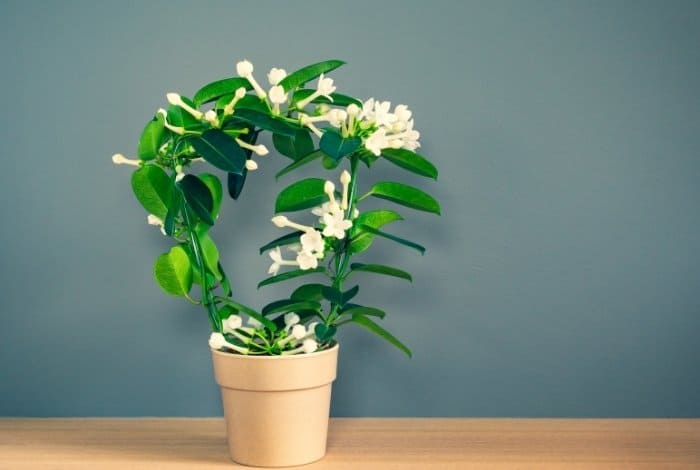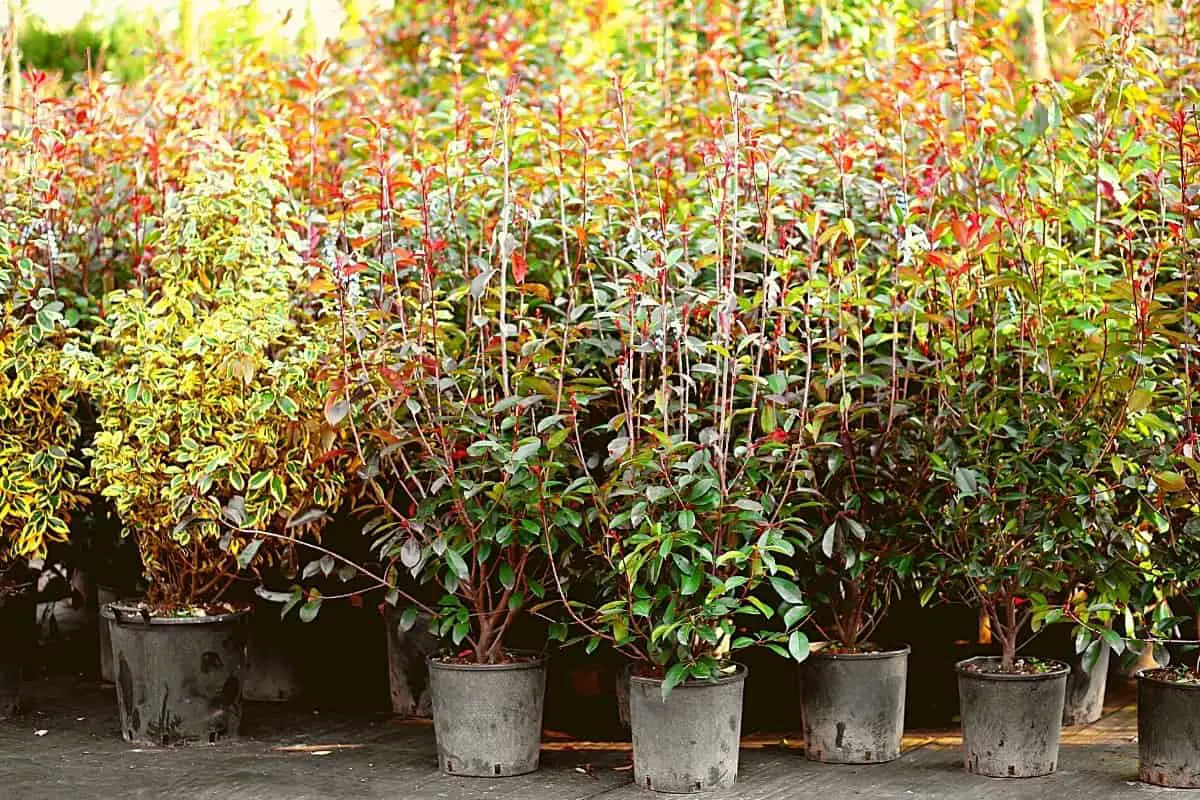Last Updated on January 17, 2022 by
When winter sets in, most people wonder can you keep a jasmine plant indoors and still have it thrive during this cold season.
Yes, it is possible to keep a jasmine plant indoors but you have to get the right indoor species.
How to Care for a Jasmine Plant Indoors
Jasmine plants thrive in adequate time outdoors to get some good amount of sunlight. Adequate sunlight encourages robust growth. And the cool autumn weather encourages buds to form for the popular February boom. Let us look at the requirements that help care for an indoor jasmine plant.
- Sunlight. If you keep the jasmine plant indoors, it must be near a window that receives sunlight throughout the day. Give them good support because they are vigorous climbers and will need firm support.
- Good Air Circulation. It helps promote the growth of Jasmine when growing it indoors. As sunlight decreases, keep the air circulation perfect even in the winter months.
- Soil. The soil should be porous and modified by adding organic materials or compost manure. The soil must remain moist throughout the year but must not be soggy. Less water is needed during the resting period when the bloom declines.
- Fertilization. An indoor jasmine plant requires fertilizer to strengthen it more. Add phosphorous to jasmine to prolong the length of its bloom time.
- Pruning. We have seen that an indoor jasmine plant grows vigorously so it needs regular pruning to keep it in shape. Prune often at the beginning of the spring season while adjusting the support.
- Pests. If you notice white cotton masses under the jasmine leaves and stems, it is a sign that mealybugs have invaded your plant. Remove as many as you can when pruning. Also, use a cotton swab dipped in alcohol to remove the masses left after pruning is finished. When cared for well, jasmine plants have a long life span.
Types of Jasmine Plant Fit for Growing Indoors
When choosing to grow an indoor jasmine plant, chose one that is based on your growing zone. While you may think your growing zone does not have much effect on an indoor plant, it plays a huge role. Factors like sunlight intensity affect how well your jasmine plant grows both indoors and outdoors.
Read more about What Does a Plant Need to Survive and Grow?
Perfect Plants Confederate Jasmine Live Plant
Here are Different Types of Indoor Jasmine Plants
- Jasminum officinale (Common Jasmine). This is a common type of jasmine that is commonly grown indoors. It is a woody vine that grows well over 10 feet in height. When grown outdoors, it attracts numerous pollinators.
- Jasminum humile (Italian Jasmine), Jasminum floridum (showy jasmine), and Jasminum Mesnyi (Primrose Jasmine). These types of jasmine do not grow over ten feet in height so they are suitable to grow indoors. They have a sweet smell and trumpet-shaped flowers.
- Jasmine Polyanthum (Winter or Pink Jasmine). It is the most popular jasmine for indoor growers. It is a popular variety that grows in the winter and can survive in USDA zones 6 to 10. It tolerates moderate frost and grows up to about 15 feet tall. You may cultivate it as a shrub. It produces pink buds and white flowers in the winter and early spring. It has clusters of blossoms that completely cover the entire plant. The blossoms appear in late February and continue to bloom throughout the sprint to early summer. This species can be cultivated as a container plant as well as outdoors.
- Jasminum polyanthum. This is a native species to Southwest China and comes with a distinctive fragrant scent. It has dark leaves ideal for house decorations in the Winter season. It produces pink buds just when the winter’s dull colors are setting in.

Conclusion
Jasmine may be the wild fruit at heart but it can be easily tamed with love! Do not let it grow too big too fast. Re-pot jasmine plant as often as possible to reduce its size significantly.
Jasmine is a climber in the wild, so to tame it you must be willing to put in the work. Try to re-pot it at least once a year during the springtime to fit its natural growth cycle. It is important to prune the plant to help the plant maintain a good shape at the end of the growing season.
The results of a well cared for plants are well worth it! You get to enjoy its natural beauty, perfumed fragrance, and bushy abundance all year round!
FAQs
Which jasmine is best for indoors?
Jasmine is a beautiful and fragrant flower that is native to southern Europe, North Africa, and Asia. The jasmine plant is often treated as an evergreen shrub, but in reality it has a much more complex life cycle.
They emit an earthy scent that may also be described as a sweet and delicate fragrance that is perfect for the indoors. The variety of jasmine plants can be divided into two types: "dry" jasmine and "wet" jasmine. If you want to use this plant in your garden, then the wet type will be better because it requires less care than the dry type.
There are three different types of jasmine you can choose from:
- Jasmine sambac: This type is best for bringing out the best of the flowers’ smell with its enticing green stems and leaves.
- Jasmine sambac grandiflora: This type has large flowers and has matured for up to nine months before blooming. It has a heavy scent that is most suitable and intense in winter time, when the air becomes cooler.
- Jasmine tricolor: This variety features bright colors and small flower clusters, thus making it more attractive than other jasmines.
How do you take care of a jasmine plant at home?
Jasmine is often found in restaurants and homes because it has medicinal properties. This is in large part due to the fact that it is a type of plant that's easy to maintain at home. It thrives in full sun and needs regular water and good drainage. The jasmine plant is one of the most popular plants that people grow at home. It is a popular tropical plant that is hardy enough to survive in cool, dry conditions. It can grow up to six feet in height and give you up to 20 feet of flowers.
If the plant grows too much, cut it back by about half. A jasmine plant makes an excellent houseplant because they are hardy and don't require much care other than watering.
It isn't difficult to care for a jasmine plant as long as you get all the right nutrients, water and care for it. However when taking care of your jasmine plant on a regular basis, there are some important things that you should keep in mind.
How quickly does jasmine grow?
Jasmine is a plant that can grow really fast. In fact, it can grow up to 10-15 centimeters in a day. This makes it difficult for gardeners to keep up with the growth of jasmine. These plants are so versatile that they can grow in different environments. They can be grown in warm or cold weather, on dry or wet soil.
Jasmine flowers grow quickly and can become invasive in some places. It can be difficult to control jasmine growth because it spreads quickly. Jasmine tends to grow on walls and supports, as well as other plants or trees near it.
Caroline is a gardener who loves to get down to the nitty–gritty of gardening. She proudly proclaims herself as a ‘dirt worshipper‘ and can often be found deep in the garden, covered in soil and singing to her plants. As a self–proclaimed ‘plant whisperer‘, Caroline believes that plants need love and attention just like any other living thing, and she loves to give them both. When she‘s not tending to her garden, you can often find her researching the latest gardening trends, or teaching others how to make their gardens thrive



